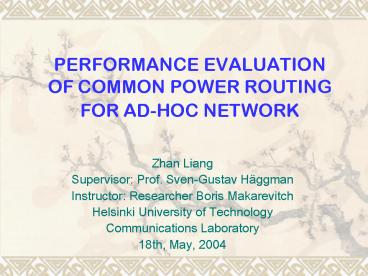PERFORMANCE EVALUATION OF COMMON POWER ROUTING FOR AD-HOC NETWORK - PowerPoint PPT Presentation
Title:
PERFORMANCE EVALUATION OF COMMON POWER ROUTING FOR AD-HOC NETWORK
Description:
Helsinki University of Technology. Communications Laboratory. 18th, May, 2004. Contents ... time-limited, and only usable for the duration of a communication ... – PowerPoint PPT presentation
Number of Views:43
Avg rating:3.0/5.0
Title: PERFORMANCE EVALUATION OF COMMON POWER ROUTING FOR AD-HOC NETWORK
1
PERFORMANCE EVALUATION OF COMMON POWER ROUTING
FOR AD-HOC NETWORK
- Zhan Liang
- Supervisor Prof. Sven-Gustav Häggman
- Instructor Researcher Boris Makarevitch
- Helsinki University of Technology
- Communications Laboratory
- 18th, May, 2004
2
Contents
- Background
- Objectives
- Introduction
- Implementation
- Evaluation of COMPOW
- Conclusion
- Future Work
3
What is Ad-hoc
- A local area network, or some small networks,
parts are time-limited, and only usable for the
duration of a communication session - The routers are free to move randomly, organize
themselves arbitrarily - The wireless topology vary rapidly and
unpredictably
4
Background
- Many power control methods are designed and
implemented over Ad-hoc networks routing
protocols (CLUSTERPOW, COMPOW, MINPOW, etc.) - Few evaluation reports on the power control
methods can be found
5
Why power control methods?
- A big effect on improving network capacity
- A higher transmit power
- a higher range and a higher signal-to-noise ratio
to the receiver - more interference to the adjacent nodes.
- Power control ? reduce the interfering nodes ?
improve the capacity - Energy Savings
6
Objectives
- To implement a common power control method
(COMPOW) over one Ad-hoc networks routing
protocol, AODV - To evaluate this power control method
7
Introduction
- Ad-hoc routing protocols
- Power control methods
8
Ad-hoc routing protocols(1)
- Table-driven all the nodes know the routing
information of the whole network - Source-initiated routes are established only
when the source nodes require them
9
Ad-hoc routing protocols(2)
10
Table-driven routing protocols Destination-Sequen
ced Distance-Vector (DSDV)
- To find the shortest paths, the least hops
- A routing table where all the routing information
is stored
11
Source-initiated routing protocols(1)Dynamic
Source Routing (DSR)
- A route cache to cache the known routes to the
destinations - Main routing functions
- Route discovery
- Route maintenance
12
Source-initiated routing protocols(2)Ad-hoc
On-Demand Distance Vector (AODV) (1)
- A combination of both DSR and DSDV protocols
- The basic route-discovery and route-maintenance
of DSR, - The hop-by-hop routing, sequence numbers and
beacons of DSDV
13
Source-initiated routing protocols(3)Ad-hoc
On-Demand Distance Vector (AODV) (2)
- Route discovery
14
Power control methods(1)
- COMPOW (COMmon POWer) control method
- CLUSTERPOW (CLUSTERing POWer) control method
- MINPOW (MINimum POWer) control method
15
Power control methods(2) COMPOW
- All the nodes use the same power level, the
lowest power level at which the network is
connected
16
Power control methods(3) CLUSTERPOW
- To separate nodes into several different clusters
17
Power control methods(3) MINPOW
- Each node chooses the transmit power level
18
Implementation of COMPOW(1)Simulation
Assumptions (1)
- Simulation Environment NS2
- Network card CISCO Aironet 350
- The channel is bi-directional link
- The free space loss with two ray ground
reflection model
19
Implementation of COMPOW(2)Simulation
Assumptions (2)
- The antennas are omni directional (same gain and
attenuation in all horizontal directions) - The MAC layer protocol IEEE 802.11b
20
Implementation of COMPOW(3)COMPOW over AODV
Route Discovery procedure
21
Implementation of COMPOW(4)Architecture
22
Implementation of COMPOW(5)Functions included in
Simulation
- Route Discovery
- Route Maintenance
- Route Release
- Route Error handle
23
Evaluation of COMPOWTesting Scenarios
- Scenario 1 10 fixed nodes, 10 pairs of
connection, 100 seconds, 250 m2 - Scenario 2 25 fixed nodes, 25 pairs of
connection, 100 seconds, 625 m2 - Scenario 3 25 mobile nodes, 25 pairs of
connection, 1000 seconds, 10001000 m2
24
ResultsThroughput vs. Load for fixed nodes (TCP)
25
ResultsThroughput vs. Load for fixed nodes (UDP)
26
ResultsEnergy Consumption vs. Load for fixed
nodes (TCP)
27
ResultsEnergy Consumption vs. Load for fixed
nodes (UDP)
28
ResultsThroughput vs. Load for mobile nodes
29
ResultsEnergy Consumption vs. Load for mobile
nodes
30
Conclusions
- A network transmitting packets by TCP COMPOW
performs good - A network transmitting packets by UDP the
lifetime of the COMPOW network may be even
shorter than that of the network without using
power control methods
31
Future works
- More complicated scenarios test ? acquire a
complete evaluation - Non-uniform load generation environment
- Other Ad-hoc routing protocols ? a more complete
evaluation of COMPOW
32
Q A
- Thank you for your attention!































